






















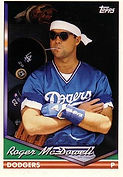




Topps continued to up its game with its 1994 set. Sharp design elements and images really make the cards pop. The Topps Gold parallel and Black Gold insert sets made return appearances, which in each case would be their last. Sticking with their 1993 format, the set was issued in two series. This year, though, they totaled 792 cards, 33 fewer than in '93.
I again ripped packs to build my set, and like many collectors was stunned by the work stoppage which resulted in the cancellation of the post season for the first time since 1904. As we finished putting together our sets, many of us wondered how long the strike could last and what impact it might have on the baseball card business AND the hobby.

Card fronts feature the player's team and position in a colored bar along the bottom, with his name in white script just above set partially against a green background. A colored border reminiscent of a partial outline of home plate surrounds the image. The image is given a large piece of real estate and the Topps wordmark appears in white in either its upper left or upper right corner.
Card backs feature a prominent image of the player along the left or right side, and include the usual statistics along with the player's vitals set against a red field.
Because they appear in script, the players' names can occasionally be difficult to read when only glanced at. Also, beginning in 1994 and lasting through 2003, the glossy coating applied to the fronts creates a friction making it difficult to thumb smoothly through a stack and, even worse, causes cards to stick together in packs and boxes when stored for years. The resulting 'bricking' of cards would be a bane for collectors looking to open packs or assemble sets for years to come.

Series 1: Cards 1-396
Images of uncut sheets are a staple of my earlier Topps set pages, but for 1994 I have been unable to locate a single such image. Initially, one might assume that because series 1 contains 396 cards, there were likely 3 132-card sheets. However, because cards in series 1 contain print codes A-F, is is probable that there were actually 6 sheets, each of which contain double printings of a 66-card block. Until images can be located, all we can do is speculate.



"Wax" packs contained 11 regular cards and one Topps Gold parallel card. Packs sold for 79 cents and were packed 36 per box. Cases held 20 boxes. Wrapper backs feature side panels which offered a "no purchase necessary" opportunity to receive a Topps Black Gold card, as well as the odds per pack of receiving various Topps Black Gold inserts - every 72 packs would produce a Black Gold card, every 180 packs would produce a an 11-card winner card, and every 720 packs would produce a 22-card winner card.


15-card hanger packs each contained 13 regular and 2 Topps Gold cards, with Black Gold cards randomly inserted.

Larger hanger packs each contained 25 regular and 4 Topps Gold cards, with Black Gold cards randomly inserted. Packs were priced at $1.99 each and came 24 per box




Jumbo packs contained 51 regular and 5 Topps Gold cards and, of course, randomly inserted Black Gold cards. Each case contained a sales display box and 24 packs.


33-card rack packs held 30 regular and 3 Topps Gold cards, a chance at Black Gold cards, and came packaged 24 packs per box.

Cases held 3 rack pack boxes.

Traditional 500-count vending boxes were also available. It is not currently known whether, as in 1993, Topps Gold cards were also available in bulk in this manner.
Of series 1's 396 cards, 340 are basic player cards. Included in this count are seven of the ten members of the 1993 Topps All Star Rookie team. The remaining 3 would appear in series 2. Those included here in series 1 are:

1 - Mike Piazza, Dodgers C
293 - J.T. Snow, Angels 1B 309 - Carlos Garcia, Pirates 2B
287 - Mike Lansing, Expos 3B
21 - Wil Cordero, Expos SS
81 - Greg McMichael, Braves RHP
72 - Steve Cooke, Pirates LHP


Each of the 28 clubs is given a Future Stars card in series 1. They feature youngsters with minimal or no MLB experience. Card backs differ from regular player cards in that the players' vitals appear against a green field, rather than a red one.
Series 1 includes five 4-player prospect cards. Each features four players at a particular position with no MLB experience, one each from AAA, AA, A and one taken in the 1993 draft. Card backs feature their career minor league stats.




Cards 201-210 feature 10 players taken in the first round of the 1993 draft. Card backs offer their high school or collegiate statistics and a brief narrative.

Cards 384-394 feature players deemed by Topps to have been the best at their positions in 1993. Each of the 8 basic defensive positions are included, as well as left and right handed starters and closers. Card backs show each player's first half, second half and total 1993 statistics.

Cards 395 and 396 are checklist cards which mark series 1 off in increments of 198: 1-198 and 199-396.
A full checklist of the entire 1994 set, in a variety of printable formats, can be found at the Trading Card Database HERE.




Card 79 can be found with background clouds partially visible through the back borders (far left) of the inset photos and, correctly, without them visible at all (left).
Card 109 can be found with Delino DeShields' team name and position printed incorrectly (and nearly invisibly) in red.
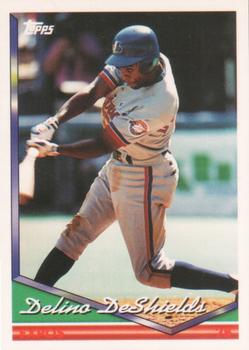

.jpg)
Card 379, Mark McLemore, is incorrectly printed as card 370.

McLemore's card also highlights an error which recurs throughout series 1 - some 135 players can be found both with and without the print code letter between the two sections of text along the bottom of the reverse. The correct versions, showing the print codes, are far rarer than the error versions without them.
Series 2: Cards 397-792
As with series 1, I was unable to locate images of uncut sheets. At 396 cards, and with sheet print codes G, H, I, J, K and L, it is reasonable to assume series 2 was also laid out across six sheets, each of which contained double-printed blocks of 66 cards.

Series 2 "wax" packs held 12 cards - 11 regular and 1 Topps Gold. They were priced at 79 cents, and were packed 36 per box, with 20 boxes per case. In addition to Black Gold and Black Gold Winner cards, special pre-production 1994 Topps Finest cards were available at a rate of 1 per box.


Series 2 cards were also issued in odd little 6-card packs (5 regular, 1 Topps Gold). Each pack also contained a piece of bubble gum. Black Gold cards could also be found. It is unknown whether such packs exist for series 1, and there is presently no information on box or case packaging.


15-card packs (13 regular, 2 Topps Gold) came packed 24 per box. Black Gold and Finest cards were randomly inserted into some packs.

Priced at $1.99, larger packs held 25 regular and 4 Topps Gold cards. They were packed 24 per box, with random packs holding Black Gold and Finest cards.

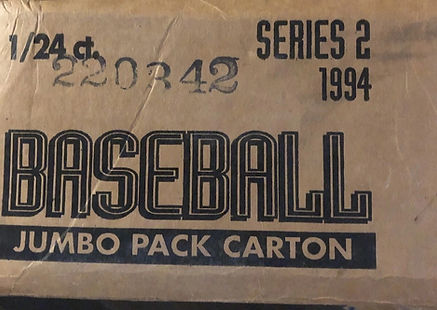


Jumbo packs held 51 regular and 5 Topps Gold cards, and could be found with Black Gold and Finest inserts. Each case held a single display tray with 24 packs.
33-card rack packs (30 regular, 3 Topps Gold) were packed 24 per box. These could also be found with Black Gold and Finest cards randomly inserted.



Cases held 3 rack pack boxes.
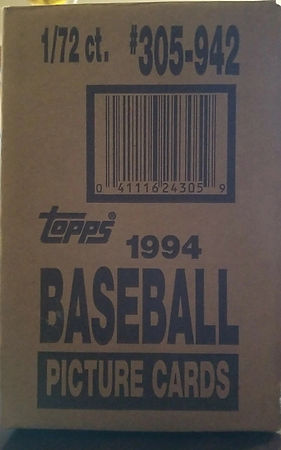
Topps also issued large cardboard dispenser displays which held 72 12-card packs. Each case contained 1 dispenser and 72 packs. It is unknown whether series 1 was also distributed in this manner.

Of 396 total series 2 cards, 327 are basic player cards.
Included in the basic player card count are 3 cards highlighting those members of the 1993 Topps All Star Rookie team not included in series 1.

397 - J.T. Snow, Angels 1B
466 - Jeff Conine, Marlins OF
508 - Wayne Kirby, Indians OF

Series 2 also was available in 500-count vending boxes.

Cards 739-762 present the other 24 players taken in the first round of the 1993 amateur draft.

Cards 601-609 present Measures of Greatness - profiles of 9 of the greatest current stars. Card backs offer a quick narrative and provide statistics comparing each player against the average Hall of Famer at the same point in his career, and against one Hall of Famer's career numbers.


Cards 763-790 feature Coming Attractions: youngsters on the cusp of their MLB debuts, one pair for each of the 28 clubs. Card backs provide the players' minor league cumulative stats and a few other bits of information.


Series 2 contains 5 4-player Prospects cards highlight players with no MLB experience. Cards group players by position, and feature draft picks as well as players at the A, AA and AAA levels. Card backs feature the players' career minor league stats.


Card 715 (see what they did there?) is a tribute to Hank Aaron on the occasion of the 20th anniversary season of his HR record breaking performance of 1974. The reverse offers some details from his storied career.
Cards 791 and 792 are checklists. They mark series 2 out by numbers 397-596 and 597-792. Card fronts are swapped (i.e. card 792 has cards 397-495 on the front), but this is an error which was never corrected.


The draft pick card of Pat Watkins (743) can be found with (left) or without (right) the usual copyright information across the bottom brown border.

Hall of Famers George Brett (180) and Robin Yount take their bows in 1994, as do Frank Viola (140), Fernando Valenzuela (175), George Bell (214), Jim Abbott (350), Kent Hrbek (490), Charlie Hough (625), Steve Sax (662) and Willie Wilson (698).
Hall of Famer Billy Wagner (209) made his debut in 1994, as did Garret Anderson (84).





Nolan Ryan, second only to Mickey Mantle on the Mt. Everest of baseball card gods, also made his final appearance in 1994. His card (34) memorializes his astonishing 27 years career on the front, and includes some of his incredible statistics in the background of this portrait on the reverse.
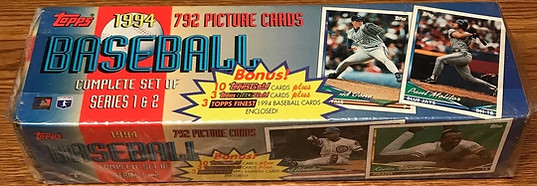
The basic, early version of the 1994 factory set contained 10 Topps Gold cards, 3 Black Gold cards and 3 Finest pre-production cards.
The late-issue version contained the Topps Gold and Black Gold cards, but lacked the Finest cards. It did include 9 1995 Topps pre-production cards as well as a Superstar Sampler pack.



The 1995 pre-production set included 9 cards of popular players in the upcoming 1995 Topps design. Each set of 9 came with a bonus "Spectra Light" parallel version of one of the cards. The effects on these cards are the same as Topps would use on their 1995 Cyber Stats cards.







A total of 46 player-specific Superstar Sampler packs were available. Each contained the player's 1994 Bowman, Finest and Stadium Club cards. Cards were exact matches to the cards available in those other sets, except for a small "Superstar Sampler" circle printed on the reverse.



Some late-issue sets contained bubble gum (left), while others carried a large gold sticker hyping the cards inside (below).
According to its coding, this case contained the late-issue sets. Whether it contained the basic version, the bubble gum version or the gold sticker version is unknown.
_edited.png)
The the first and only time (so far), Topps issued a special "Bilingual" set in 1994. Card fronts were identical to those in the basic set, while backs featured narratives in both English and Spanish.



Exclusive to these sets was a 10-card set of "Leyendas" or Legends. Each card featured one of MLB's prominent early Latin players.

For the third year in a row, Topps produced a Topps Gold parallel version of its set. All 792 cards (minus the 4 checklists) were printed with the player's name overlaid in embossed gold foil. The Topps word mark in the upper corner was replaced with a similarly golden Topps Gold word mark. .
In place of the 4 checklists, the following players who are not included in the basic set were featured on Topps Gold cards:
395 - Bill Brennan (Cubs)
396 - Jeff Bronkey (Rangers) [left]
791 - Mike Cook (Orioles)
792 - Dan Pasqua (White Sox)


The 1994 Black Gold set consists of 44 cards, each of which depicts a prominent player silhouetted against black with gold foil elements at the top and bottom. Card backs offer some of the player's 1993 statistics and where they ranked in their respective leagues. Cards were randomly inserted into packs in all packaging formats.



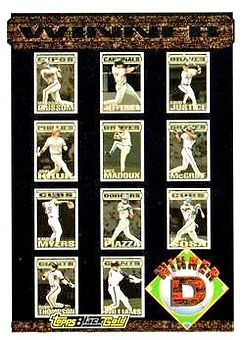
The 44-card set was organized into groups of 11 lettered A (1-11), B (12-22), C (23-33) and D (34-44). Groups A and B were included in series 1 packaging and groups C and D in series 2. Instant winner cards were also randomly inserted which would entitle the bearer to complete sets of groups A, B, C or D, as well as groups A/B combined, C/D combined and A/B/C/D combined. Single group winners were inserted at rates less than regular Black Gold cards themselves, double winners at still lower rates and the quad winner even far lower still.
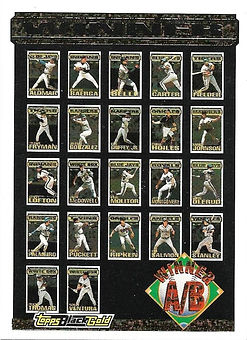


Winning cards found in packs include a form to complete to claim the cards on the reverse (below left) and winning cards mailed out with the cards include something of a congratulatory statement and checklist of the cards received (below right).

Winning groups were mailed out in cellophane packs. Winner cards received in these packs also had the word "Certified" placed on the front below the series letter(s) won.


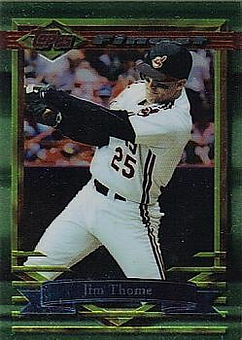

Also inserted into packs and factory sets were 1994 Finest pre-production cards. 40 cards from the 1994 Finest set were included, and each mirrors its regular Finest card, but adds "Pre-Production" in red type diagonally across the statistics section on the reverse.

We don't know when, how many or in what packaging formats they were issued, but some individuals pulled cards entltling them to a single Finest pre-production insert card.




Topps again produced a 132-card boxed Traded set late in the season to reflect those players who had changed teams and youngsters not included in the base set. Cards are numbered 1T-132T.
The set contains 106 basic player cards. Also included are 19 draft pick cards (which mirror their counterparts in the basic set except they include players taken in the 1994 draft), a single 4-player prospect card, one Future Star card and a checklist.
Rounding out the 132-card count are 2 "Anatomy of a Trade" cards highlighting key deals made during the first half of the season and 2 commemorative cards (130, 131) of Ryne Sandberg, who would retire in 1994 (before making a comeback in 1996 and retiring again in 1997).
With the exception of the addition of a "T" to card numbers, the Traded cards are indistinguishable from cards in the main set.





The 1994 Traded set includes the final card of Hall of Famer Jack Morris (36T).

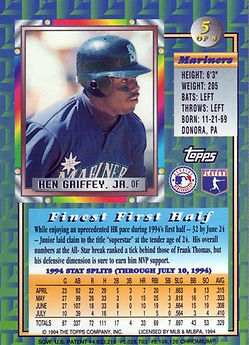
Each set included an 8-card Finest set highlighting those players most likely to win MVP and Rookie of the Year awards in 1994 based on their first half performances. Topps was not entirely prescient as this set does not include eventual AL ROY Bob Hamelin or eventual NL MVP Jeff Bagwell.


As was their wont in this era, Topps included cards in both the basic and Traded sets which were formatted horizontally to permit wider and more interesting images.


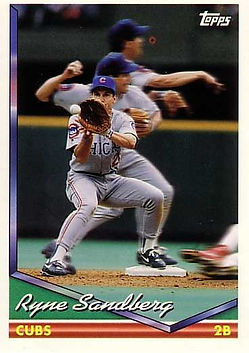

Topps also experimented with some 'special effects' on these cards of Ryne Sandberg (300) and Bret Barberie (132).
As in previous years, posters designed for store display were packed as box-toppers in some series 1 boxes.
.jpg)